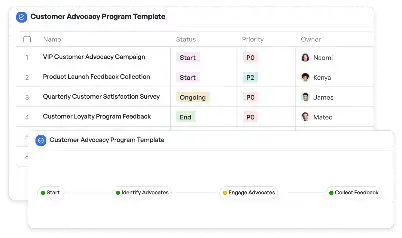Semiconductor Defect Classification
Achieve project success with the Semiconductor Defect Classification today!

What is Semiconductor Defect Classification?
Semiconductor Defect Classification is a critical process in the semiconductor manufacturing industry. It involves identifying, categorizing, and analyzing defects that occur during the production of semiconductor devices. These defects can range from surface irregularities to internal structural issues, and their classification is essential for maintaining product quality and yield. By leveraging advanced technologies such as machine learning and image processing, Semiconductor Defect Classification enables manufacturers to pinpoint defect sources, optimize production processes, and ensure compliance with industry standards. This process is particularly important in high-precision environments where even minor defects can lead to significant performance issues or product failures.
Try this template now
Who is this Semiconductor Defect Classification Template for?
This Semiconductor Defect Classification template is designed for professionals and teams involved in semiconductor manufacturing and quality assurance. Typical users include process engineers, quality control specialists, and R&D teams who need a structured approach to manage defect data and classification workflows. It is also valuable for production managers overseeing large-scale manufacturing operations and academic researchers studying defect patterns and their impact on semiconductor performance. By providing a standardized framework, this template helps users streamline their defect classification processes and collaborate effectively across departments.

Try this template now
Why use this Semiconductor Defect Classification?
The Semiconductor Defect Classification template addresses several pain points specific to the semiconductor industry. For instance, identifying and categorizing defects manually can be time-consuming and prone to errors, especially when dealing with large volumes of data. This template automates key aspects of the classification process, reducing the risk of human error and ensuring consistency. Additionally, it provides a centralized platform for storing and analyzing defect data, making it easier to identify trends and implement corrective actions. By using this template, manufacturers can improve product quality, reduce waste, and enhance overall operational efficiency, all while staying ahead in a highly competitive market.

Try this template now
Get Started with the Semiconductor Defect Classification
Follow these simple steps to get started with Meegle templates:
1. Click 'Get this Free Template Now' to sign up for Meegle.
2. After signing up, you will be redirected to the Semiconductor Defect Classification. Click 'Use this Template' to create a version of this template in your workspace.
3. Customize the workflow and fields of the template to suit your specific needs.
4. Start using the template and experience the full potential of Meegle!
Try this template now
Free forever for teams up to 20!
The world’s #1 visualized project management tool
Powered by the next gen visual workflow engine




